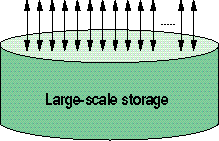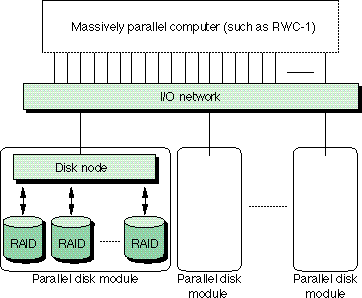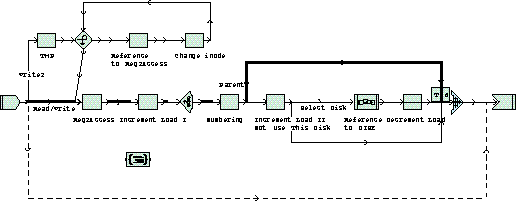
1. What are the objectives of research?
Most of the applications executed on massively parallel computers handle large amounts of data, such as large-scale simulation and image recognition of real-world phenomena, and large-scale database processing. Massively parallel computers therefore need to have large-scale storage systems in order to store such data. In addition, it is necessary to transmit large amounts of data between a massively parallel computer and the storage system at speeds fast enough to keep up with the operating speed of the massively parallel computer.
Since data are being processed in parallel on many processors, storage systems have to be able to allow concurrent access to large quantities of data whenever requested by the processors. The parallel storage system that we aim to develop is a large-capacity storage system which has a large number of "data entries and exits," as shown in Fig. 1.

2. What is our approach?
To achieve this, one method might be to arrange many disks in parallel. Conventionally, central control of data requests and data locations may be possible when the number of disks connected in parallel is limited to 10 or 20. However, when the number of disks increases, efficient central control of data requests and data locations is no longer possible. For instance, having a single control point for data accesses to 1000 disks would rapidly lower the system's efficiency.
What we have in mind, therefore, is a parallel storage system in which the constituent disks can exchange information and cooperate with each other, as shown in Fig. 2.

Fig. 3 shows the configuration of the parallel storage system we plan to construct. In this configuration, large numbers of disks are connected to a massively parallel computer via an I/O network. Several disks form a cluster, and several disk clusters (called parallel disk modules) then combine to form the entire disk system. Each disk cluster has one disk node that executes distributed control of data requests from processors and data locations. Disk nodes exchange information about the access status of each disk cluster.

Since the parallel storage system consists of a large number of disks, attention has to be given to assure its reliability .
3. What is the current status?
This section describes our recent activities.
In general, as the number of disks increases, it becomes more difficult to run all the disks efficiently. It may happen that some disks are busy handling data requests, while other disks are idle, with almost no workload; thus, 1000 disks will not be 1000 times more efficient than one disk.
In order to run this type of "massively parallel disk system" efficiently, we have established a method of distributing data requests evenly to all disks. Using this method, concentration of the workload on some disks can be avoided, so that a bottleneck will not form. The effectiveness of this method has been verified on a simulator (see references [1] and [2]).
The "I/O network" serving as a data path between a massively parallel computer and the storage system is also an important component in achieving our goal. It should be capable of transmitting large quantities of data in parallel at high speed. We have also investigated the network topology and data transfer methods needed to achieve this (see reference [3]).

4. What is our future work?
We are planning to verify the effectiveness and performance of our methods on actual machines. This year we are building a test system to do this. That is a parallel storage system (parallel disk module) in a minimum configuration with eight disks and a disk node. Starting from FY 1996, a prototype parallel storage system will be constructed, to be connected to RWC-1 for performance evaluation with real applications.
References
[1] Oue, Kitamura, Ohnishi, Shimizu: Dynamic Load Balancing of File Access on Parallel Secondary Storage. IPSJ, SIG NOTES ARC-112-1, 1995.6, pp. 1-8.
[2] Oue, Kitamura, Ohnishi, Shimizu: Parallel File Access for Dynamic Load Balancing on the Massively Parallel Computer. Proc. Intl. Symp. on Parallel and Distributed Supercomputing, 1995.9.
[3] Ohnishi, Kitamura, Oue, Shimizu: Network Architecture and Performance Evaluation for a Dispersive Independent I/O System. IPSJ, SIG NOTES ARC-111-6, 1995.3, pp. 41-48.